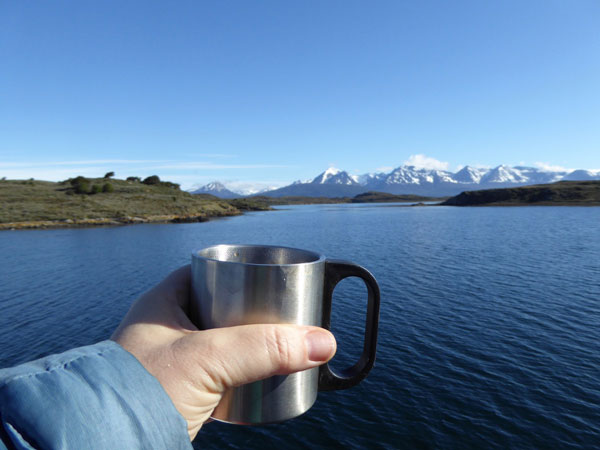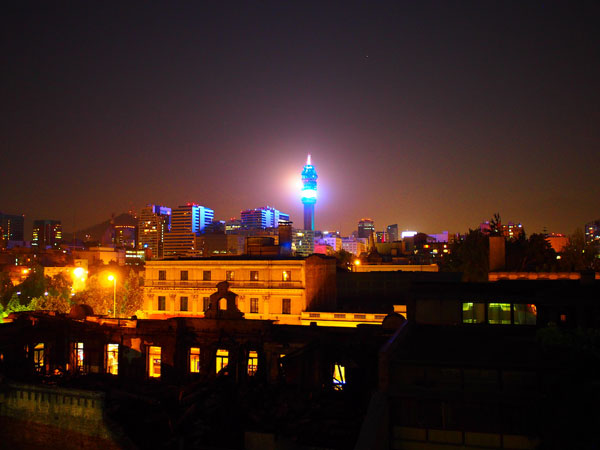Everyone in Chile is crazy about the alerce (a-LEHR-say). The alerce is Chile’s redwood, its giant sequoia. A huge hardwood tree that was overharvested almost to extinction. It grows gigantically tall and hugely round and for a thousand years. It fills an important ecological niche, is present only in a few isolated stands and rooves the old cottages and houses with a characteristic shingle that doesn’t podrir (rot). In English it’s the false larch. Which to you means nothing. But to lovers of ecology, of the giant trees you can look up the trunks of and perceive them disappearing into the sky, visiting the few remaining stands of alerce in the south of Chile is bittersweet. They’re magestic, to be sure, but they represent what’s wrong with resource exploitation and logging and disrespect for traditional ways and the environment.
The alerce is important, and I get what it represents, I just don’t love this tree with my heart and soul. It doesn’t reel me in. Also, despite the fact that they stand stock still, I was unable to photograph one to my satisfaction last summer while visiting Parque Pumalín, the humongous private park owned by American business mogul/environmentalist Douglas Thompkins that spans almost an entire degree of latitude across Chile. So there will be no photos of alerces today. At least not here.
Instead I will tell you about my tree. Yes, I have a tree. Well, many trees. It is not endangered, no one ever cuts it down to roof their house, and even monkeys find it troublesome. Not that we have monkeys in Chile, but you know. It’s called the monkey puzzle tree in English, or the Arucaria in Spanish. (ah-ru-CAR-ee-a). And I love it.
I love how they look from afar.
And from below
from up close
and from even closer
Even after death by flame and smoke, they remain dignified, seeming to implore the sky for rain, a chance for a new generation to grow.
The araucaria is not particularly huggable, what with the sharp angry-looking spikes on every branch. But I still love it. If it’s close, if it’s far. Even if it’s planted in Santiago, which it doesn’t much like, as it’s too hot in the summer and it becomes leggy, and has to strain to grow. Arucarias reminds me of the hens and chicks my mom grew on the back porch in an old sink when I was a kid in Brooklyn. Who knew that something so new could seem so familliar?















I love the Araucania too!! They are special trees…though the Arrayanes is pretty high on my list too!
hola, descubrí tu blog por medio del foro de ciclistas bikemontt, soy Chileno y me parece muy divertido el como intentas explicar los extraños modismos, costumbres y cultura de nuestro país. Sin duda muy necesario para sobrevivir y no quedar como “el gringo que no cacha ni una”.
Otro punto, no es necesario viajar hasta Pumalin para ver alerces… de Valdivia a Puerto Montt tambien hay, pero algo escondidos.
Yo prefiero el alerce por su longevidad, su belleza y su madera, ademas de ser uno de las pocas especies que crecen en terrenos pesimos para cualquier otro arbol.
La araucaria forma bonitos bosques y nos regala frutos comestibles: “piñon”, que es uno de los principales alimentos para el pueblo mapuche – pehuenche.
suerte con tu postulacion a lonely planet.
@ Living in Patagonia, well, you’d have to love them, living where you do. Arrayans are pretty, but they seem so new, and they look so easy to grow. These two trees look like they know how to fight! Thanks for commenting!
@ Fabián, Sí sé que los alerces se pueden ver mas cerca, pero por tanto que me habían hablado de ellos, la primera vez que los vi fue justo en el Pumalín, despues de unos 3.5 años acá en Chilito. Quise escribir también del piñon, y lo iba a dejar por otro momento. En EEUU tambien hay un fruto de arbol (en este caso, un pino) que se llama piñon, pero es otra cosa. Me sorprendí con el gran tamaño de los piñones de acá y tambien con el alto contenido de almidón, siendo que los piñones norteamericanos son pura grasa!
Gracias por comentar!
I much prefer the alerce’s other moniker in English – Patagonian cypress. I mean, after all, it’s kind of hard to get excited about something called a larch, let alone a false one.
I agree that araucaria trees are very cool. I never thought of them as hens and chicks in tree form!
Those are beautiful pictures! A few of those would make wonderful desktops for a computer. The Arucaria sounds familiar. Was it mentioned it the Disney cartoon The Three Caballeros?
@ katie, good point about the name. It certainly does sound more majestic that way! And I just saw piñones in the grocery store today. They must be in season.
@ sunrunner, no idea about the tree re: movie. I’m not much of a movie watcher, and kids’ movies, even less! But let me know if you find out. Would have been good trivia for the post. If only I’d known.